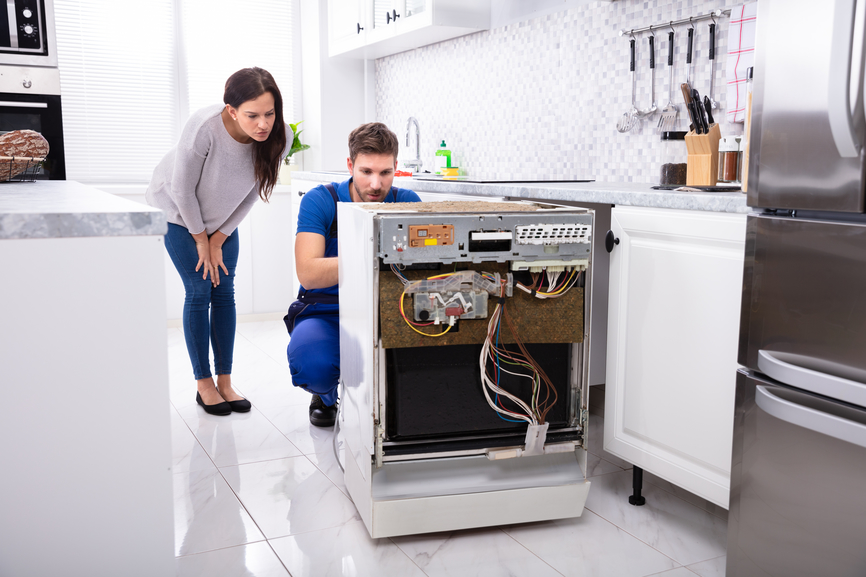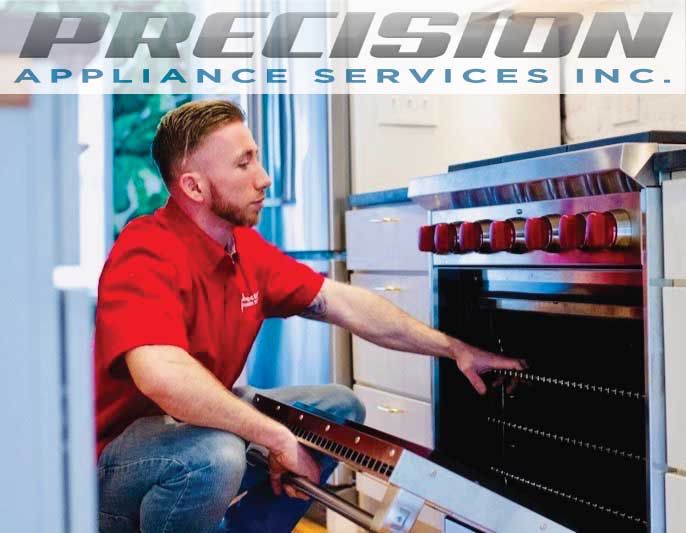The Ultimate Overview to Understanding Appliance Repair Work at Home
When your refrigerator quits cooling down or your stove refuses to warmth, it can feel frustrating. Recognizing device repair in the house can conserve you money and time. You'll discover to identify symptoms, make use of important tools, and follow a systematic troubleshooting process. Yet before you begin, there are important safety preventative measures you need to take into account. What are the most typical problems, and how can you fix them? Let's explore the basics.
Common Device Issues and Their Signs and symptoms
When your appliances begin breaking down, it's necessary to recognize the indications at an early stage. Neglecting them can result in bigger concerns and pricey repair services. If your fridge isn't cooling down correctly, you might notice cozy areas or condensation creating. This can suggest a stopping working compressor or an obstructed vent.Your dishwashing machine may reveal troubles with unclean meals or uncommon sounds throughout cycles. If you listen to grinding or clanking, it's time to investigate.A washing device that won't rotate or drain pipes can leave you with soggy washing, suggesting a clogged drainpipe or a malfunctioning pump.Lastly, if your oven's temperature level seems off or it takes forever to preheat, you could be managing a defective thermostat. By remaining alert to these signs, you can attend to problems prior to they escalate into major repair services.
Necessary Tools for Device Fixing
When you're dealing with appliance repair services in your home, having the right devices is necessary. Standard hand devices like screwdrivers and pliers will assist you disassemble and repair different devices, while electrical screening devices ensure you're functioning safely with electrical wiring. Let's review what you require to obtain started on your fixing journey.
Standard Hand Devices
Having the right tools is important for effective device repair service in the house. Start with a trusted screwdriver set, including both flathead and Phillips types, as screws are common in home appliance setting up. Pliers are likewise important; they assist with gripping, twisting, and reducing cables or small parts. A pair of needle-nose pliers can get to limited places conveniently. You'll need a good flexible wrench for tightening up or loosening up nuts and screws. An energy blade is convenient for puncturing packaging or insulation. Ultimately, do not forget a sturdy workbench or surface to safely organize your tools and components. With these basic hand tools, you'll be well-prepared to take on most home appliance repair work that come your way.
Electric Screening Gadgets
Alongside basic hand devices, electrical testing devices play a crucial duty in device fixing. These devices assist you detect electric concerns and guarantee appliances operate safely. A multimeter is important; it gauges voltage, current, and resistance, allowing you to pinpoint problems promptly. A non-contact voltage tester is an additional essential, letting you detect online cords without making direct contact, boosting your safety. Clamp meters are terrific for determining current circulation in cables without disconnecting them, conserving you time and initiative. In addition, circuit testers can promptly inspect if outlets are operating effectively. By using these devices, you'll improve your troubleshooting process and enhance your fixing abilities, making home appliance upkeep a whole lot simpler.
Step-by-Step Overview to Diagnosing Appliance Issues
When your device breaks down, it can be discouraging, however identifying the problem does not have to be frustrating. You'll discover to determine common issues and apply efficient troubleshooting techniques. Let's go through the actions to get your device back in working order.
Typical Appliance Troubles

Troubleshooting Strategies Clarified

Fixing Major Kitchen Appliances: A Closer Look
Have you ever questioned how to tackle common issues with your kitchen appliances? Fixing major cooking area devices like refrigerators, ovens, and dishwashers can be simpler than you believe. Begin by recognizing the problem-- whether it's a fridge not cooling or a stove that will not heat. Usually, a straightforward reset or checking the source of power can solve the issue.For fridges, clean the condenser coils and check the door seals. If your stove's not heating, inspect the home heating element and thermostat. Dishwashers might simply need a tidy filter or a reset to get them back at work. Always unplug the appliance before diving right into repairs to assure your safety.Don' t fail to remember to seek advice from the individual guidebook for certain repairing ideas associated with your version. With a bit of persistence and the right tools, you can confidently tackle home appliance repairs and conserve money in the procedure!

Repairing Laundry Appliances: Tips and Techniques
When your laundry devices begin acting up, it can feel frustrating, however troubleshooting them does not have to be a hassle. Start by inspecting the power supply. Verify the device is connected in and the outlet is working. Next off, examine the door or cover switch; a defective button can avoid the machine from operating.For washing machines, if it's not spinning, look for out of balance lots. Redistributing the garments could solve the concern. If your clothes dryer isn't heating, tidy the lint filter and inspect the vent for blockages.Listen for uncommon noises; they can show an issue. If your home appliance is dripping, examine the hoses for cracks or loosened links. Paper any error codes displayed on electronic displays, as they can assist you in recognizing the problem. Seek advice from the individual handbook for specific troubleshooting tips connected to your version.
Security Precautions to Take During Repairs
Prior to you begin any kind of home appliance repair work, it's vital to prioritize look here security to avoid accidents or injuries. Disconnect the device or transform off the circuit breaker to guarantee no power reaches it while you work. Usage shielded devices to decrease the risk of electric shock. Use safety and security goggles and gloves to protect on your own from sharp edges or debris (Dependable Refrigeration & Appliance Repair Service Washer repair near me).Make certain your work space is tidy and well-lit, so you can see what you're doing. Maintain youngsters and animals far from the location to avoid diversions and potential hazards. If you're handling gas appliances, be added cautious; check for leaks prior to proceeding.Take your time, and do not rush with repair services. If you really feel uncertain concerning any kind of step, it's far better to pause and this link research study than to guess. Following these safety measures will certainly help produce a more secure setting for your do it yourself appliance repair work project
When to Call a Professional for Aid
Just how do you know if it's time to call a professional for home appliance fixings? If you've tried fundamental troubleshooting without success, it's a clear sign. For example, if your device still won't begin or reveals uncommon noises after resetting it, don't think twice to seek expert help.When you notice leakages, smoke, or burning scents, prioritize security and call a professional immediately. These concerns can cause more considerable damage or pose dangers to your home.Also, if your home appliance is under warranty, speaking to a professional is commonly the very best route. They can ensure that repairs will not invalidate your service warranty, saving you money in the long run.Finally, if you're uncertain or uneasy with complicated repairs, it's smart to leave it to the experts. Bear in mind, taking on complex concerns without the right know-how can cause expensive errors. Count on an expert when unsure!
Frequently Asked Concerns
How Can I Protect Against Device Issues in the Future?
To avoid home appliance problems in the future, you must execute regular maintenance, look for deterioration, tidy filters, and stay clear of overloading. Remaining proactive will certainly help extend their life expectancy and keep them running efficiently.
What Are one of the most Usual Do It Yourself Home Appliance Repair Work Mistakes?
You may overlook safety precautions, avoid fixing steps, or make use of incorrect tools when trying do it yourself home appliance fixings. Rushing the process or ignoring maker standards can bring about more significant problems and costly errors. Stay person and educated!
How Do I Know if a Part Needs Substitute?
You can tell if a part requires replacement by examining for unusual noises, leaks, or irregular performance. If the appliance battles to operate correctly or shows noticeable damages, have a peek at this site it's likely time for a substitute.
Can I Utilize Generic Components for Appliance Services?
Yes, you can use common components for appliance fixings, yet establish they're suitable - Dependable Refrigeration & Appliance Repair Service Dryer repair near me. Common parts might conserve you money, yet they could impact performance or durability, so evaluate your choices very carefully prior to making a decision
What Guarantees Cover Device Services?
A lot of home appliance warranties cover repair work for manufacturing problems, however they usually leave out damages from misuse. Inspect your guarantee terms thoroughly, as some may require utilizing qualified specialists and original components for protection to stay valid.